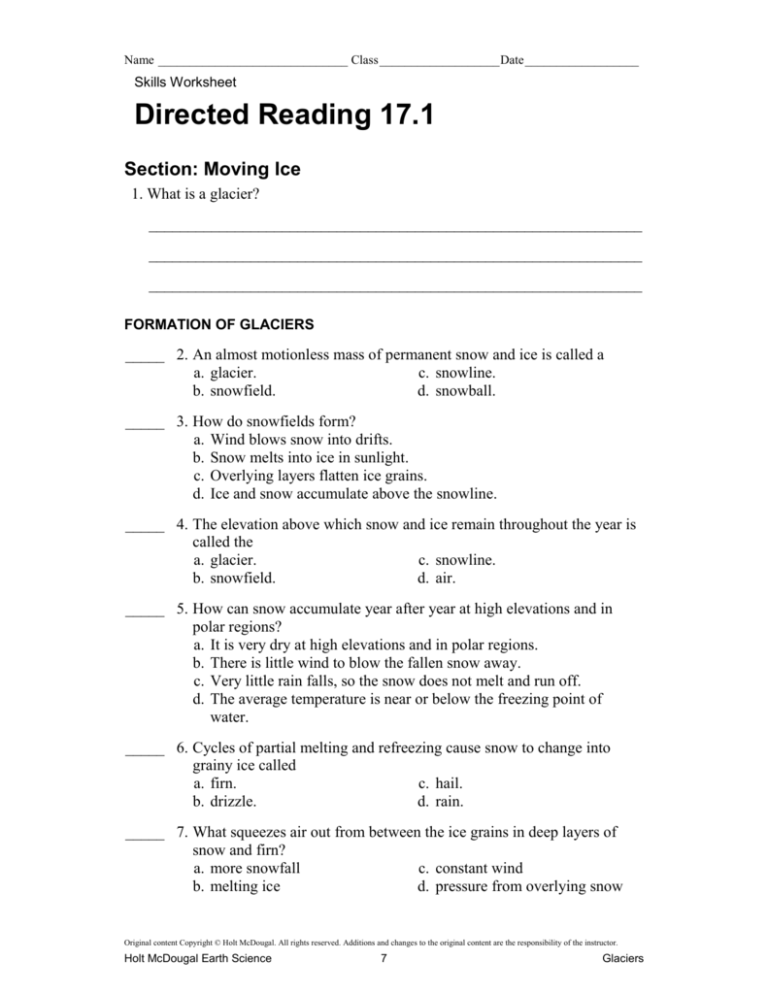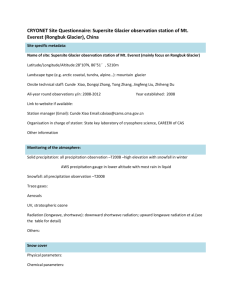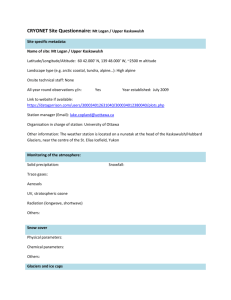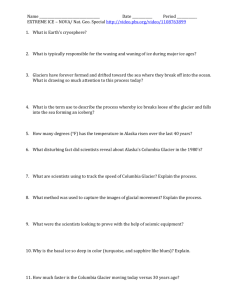
Name ______________________________ Class ___________________ Date __________________
Skills Worksheet
Directed Reading 17.1
Section: Moving Ice
1. What is a glacier?
_______________________________________________________________
_______________________________________________________________
_______________________________________________________________
FORMATION OF GLACIERS
_____ 2. An almost motionless mass of permanent snow and ice is called a
a. glacier.
c. snowline.
b. snowfield.
d. snowball.
_____ 3. How do snowfields form?
a. Wind blows snow into drifts.
b. Snow melts into ice in sunlight.
c. Overlying layers flatten ice grains.
d. Ice and snow accumulate above the snowline.
_____ 4. The elevation above which snow and ice remain throughout the year is
called the
a. glacier.
c. snowline.
b. snowfield.
d. air.
_____ 5. How can snow accumulate year after year at high elevations and in
polar regions?
a. It is very dry at high elevations and in polar regions.
b. There is little wind to blow the fallen snow away.
c. Very little rain falls, so the snow does not melt and run off.
d. The average temperature is near or below the freezing point of
water.
_____ 6. Cycles of partial melting and refreezing cause snow to change into
grainy ice called
a. firn.
c. hail.
b. drizzle.
d. rain.
_____ 7. What squeezes air out from between the ice grains in deep layers of
snow and firn?
a. more snowfall
c. constant wind
b. melting ice
d. pressure from overlying snow
Original content Copyright © Holt McDougal. All rights reserved. Additions and changes to the original content are the responsibility of the instructor.
Holt McDougal Earth Science
7
Glaciers
Name ______________________________ Class ___________________ Date __________________
Directed Reading continued
_____ 8. Which of the following causes a glacier to move downslope or
outward?
a. its own weight
c. a stream of melted ice
b. underlying ice
d. heat from the sun
_____ 9. The size of a glacier depends on the amount of
a. ice added and the amount of snow blown away.
b. snow received and the amount of ice lost.
c. ice received and the amount of snow lost.
d. snow received and the amount of snow that melts.
10. Under what conditions does a glacier get smaller?
_______________________________________________________________
_______________________________________________________________
_______________________________________________________________
11. Describe how changes in the size of a glacier may indicate climatic change.
_______________________________________________________________
_______________________________________________________________
_______________________________________________________________
TYPES OF GLACIERS
12. A glacier that forms in a mountainous region is called a(n)
_____________________________ glacier.
13. Why are alpine glaciers confined to small areas?
_______________________________________________________________
_______________________________________________________________
_______________________________________________________________
14. Name five regions in the world where alpine glaciers are found.
_______________________________________________________________
_______________________________________________________________
_______________________________________________________________
_______________________________________________________________
_______________________________________________________________
_______________________________________________________________
Original content Copyright © Holt McDougal. All rights reserved. Additions and changes to the original content are the responsibility of the instructor.
Holt McDougal Earth Science
8
Glaciers
Name ______________________________ Class ___________________ Date __________________
Directed Reading continued
15. Massive sheets of ice that may cover millions of square kilometers are called
______________________ glaciers.
16. Another name for a continental glacier is a(n) ______________________.
17. In which two regions of the world do continental glaciers exist?
_______________________________________________________________
18. The maximum thickness of the Antarctic ice sheet is more than
______________________ in some places.
19. If the Antarctic and Greenland ice sheets melted, the water they contain would
raise the sea level worldwide by more than ______________________.
MOVEMENT OF GLACIERS
_____ 20. What causes glaciers to flow downward?
a. melting
c. wind
b. gravity
d. snowfall
_____ 21. By how many basic processes do glaciers move?
a. one
c. three
b. two
d. four
_____ 22. The process that causes a glacier’s base to melt and the glacier to slide
is called
a. glacial flow.
c. basal slip.
b. ice sheeting.
d. glacial impact.
_____ 23. In the process of basal slip, the glacier moves
a. after ice particles change shape and slide past one another.
b. after temperatures drop below freezing.
c. by sliding over a thin layer of water and sediment.
d. when wind pushes the ice downhill.
_____ 24. A glacier that moves by basal slip can work its way over small
barriers by
a. melting and refreezing.
c. moving more quickly.
b. moving more slowly.
d. touching the ground.
25. Describe the process of internal plastic flow.
_______________________________________________________________
_______________________________________________________________
Original content Copyright © Holt McDougal. All rights reserved. Additions and changes to the original content are the responsibility of the instructor.
Holt McDougal Earth Science
9
Glaciers
Name ______________________________ Class ___________________ Date __________________
Directed Reading continued
26. Name three factors that determine the rate at which ice flows at a given point.
_______________________________________________________________
_______________________________________________________________
_______________________________________________________________
27. Why do the edges of a glacier move more slowly than its center?
_______________________________________________________________
_______________________________________________________________
_______________________________________________________________
_______________________________________________________________
FEATURES OF GLACIERS
In the space provided, write the letter of the description that best matches the term
or phrase.
_____ 28. crevasse
_____ 29. ice shelf
a. large block of ice that breaks from an ice shelf
b. part of an ice sheet that moves out over the ocean
c. large crack on the surface of a glacier
_____ 30. iceberg
31. Why does the ice on the surface of a glacier remain brittle?
_______________________________________________________________
32. How does a crevasse form on the surface of a glacier?
_______________________________________________________________
33. A crevasse on the surface of a glacier can be as deep as
______________________.
34. In which direction do continental glaciers move?
_______________________________________________________________
35. Rising and falling tides can cause a(n) ______________________ to break off
of an ice shelf.
36. Why do icebergs pose a hazard for ships?
_______________________________________________________________
_______________________________________________________________
Original content Copyright © Holt McDougal. All rights reserved. Additions and changes to the original content are the responsibility of the instructor.
Holt McDougal Earth Science
10
Glaciers









